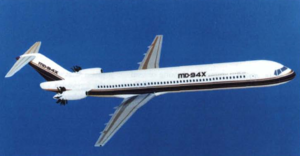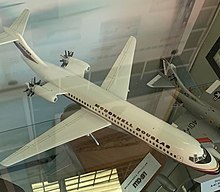McDonnell Douglas MD-94X
| MD-94X | |
|---|---|

| |
| A model of the proposed McDonnell Douglas MD-94X clean-sheet aircraft with two propfan engines. | |
| Role | Airliner |
| National origin | United States |
| Manufacturer | McDonnell Douglas |
| Status | Canceled project |
| Number built | None |
| Developed from | McDonnell Douglas MD-80 |
The McDonnell Douglas MD-94X was a planned propfan-powered airliner, intended to begin production in 1994. Announced in January 1986,[1] the aircraft was to seat between 160 and 180 passengers,[2] possibly using a twin-aisle configuration.[3] An all-new design that was investigated internally since at least 1984,[4] the MD-94X was developed in the mid-1980s to compete with the similar Boeing 7J7. The price of oil would have to be at least US$1.40 per gallon for McDonnell Douglas to build the plane, though.[5] Configuration was similar to the MD-80, but advanced technologies such as canard noseplanes,[6] laminar and turbulent boundary layer control, side-stick flight control (via fiber optics), and aluminum-lithium alloy construction were under consideration.[7] Airline interest in the brand-new propfan technology was weak despite claims of up to a 60% reduction in fuel use, and both aircraft were canceled.[citation needed]
Under development at the same time were two propfan-powered commercial variants of the MD-80. The "MD-91X" would have seated 100-110 and entered service in 1991. The "MD-92X," a 150-seat aircraft targeted for service entry in 1992,[2] was originally to be a 76 in stretch (1.9 m) of the MD-80.[3] The price per engine would have been an estimated US$1.6 million dollars more for the propfans than for the MD-80's Pratt & Whitney JT8D-200 series engines.[8] Existing DC-9s and MD-80s would also have been eligible for an upgrade to the new propfan powerplants.[9] On May 19, 1987, McDonnell Douglas tested General Electric Aviation's unducted fan (UDF) engine in flight for the first time on an MD-80 demonstrator,[10] an aircraft that was restored after suffering an empennage separation in 1980 during the landing of a certification test flight for the DC-9 Super 80.[11]
A propfan-powered military variant of the MD-87 or MD-91X, called the P-9D, was also proposed as an anti-submarine warfare (ASW) aircraft. The P-9D was intended for use in the United States Navy's Long Range Air ASW-Capable Aircraft (LRAACA) program, which was to initially replace the existing fleet of 125 Lockheed P-3 Orion aircraft.[12] In October 1988, the Navy selected a derivative of the P-3 Orion (which was later renamed Lockheed P-7A) as the LRAACA aircraft over the P-9D.[13]
On October 10, 1989, McDonnell Douglas publicly announced that it was abandoning the development of propfan-powered aircraft, because of airline companies were concerned about the technology risk and cost compared to a conventionally-powered airliner.[14]
Specifications[edit]

| Airplane | MD-91X[15] | MD-92X[15] | MD-94X | P-9D[12] |
|---|---|---|---|---|
| Derived from[9] | MD-87 | MD-88 | N/A (clean sheet) | MD-87 or MD-91X |
| Mixed-class seats | 114 | 165 | N/A | |
| Sale price[16] | US$25 million | >US$30 million | ||
| Length | 120 ft 11 in (36.86 m)[17] | 157 ft 4 in (47.96 m)[17] | 132 ft 2 in (40.3 m) | |
| Operating empty weight | 83,508 lb (37,879 kg) | 91,579 lb (41,540 kg) | ||
| MTOW | 133,000 lb (60,000 kg) | 155,000 lb (70,000 kg) | 165,000 lb (75,000 kg) | |
| Cruise speed | Mach 0.76 | 430 knots (490 mph; 800 km/h) | ||
| Range | 2,563 nmi (2,949 mi; 4,747 km) | 2,424 nmi (2,789 mi; 4,489 km) | 2,000 nmi (2,300 mi; 3,700 km) (4-hour loitering time) | |
| Takeoff field length[18] | 5,200 ft (1,600 m) | 7,000 ft (2,100 m) | ||
| Engines (×2) | General Electric GE36-C22 or PW-Allison 578 |
General Electric GE36-C25 or PW-Allison 578 |
General Electric GE36 or PW-Allison 578-D[13] | |
| Thrust per engine | 22,000 lbf (98 kN) | 25,000 lbf (110 kN) | 25,000 lbf (110 kN) | |
| Lower hold cargo volume | 773 cu ft (21.9 m3) | 1,250 cu ft (35 m3) | N/A | |
See also[edit]
Related development
Aircraft of comparable role, configuration, and era
References[edit]
- ^ Ramsden, J. M. (February 22, 1986). "Propfans—'the genie is out of the bottle'" (PDF). Air Transport. Flight International. Vol. 129, no. 3999. New Delhi, India. p. 8. ISSN 0015-3710. Retrieved May 17, 2019.
- ^ a b Haggerty, James J. (1987-08-01). "Toward future flight". Spinoff (PDF) (1987 ed.). NASA (published August 1987). pp. 30–33. hdl:2060/19880002195. OCLC 17914180. Archived from the original on April 12, 2009.
- ^ a b Kehe, R. N.; Morrison, Jr., H. F. (September 15–18, 1986). Cargo airlift: what's old? What's new?. International Forum for Air Cargo and International Air Cargo Exposition. SAE Technical Papers (13th ed.). Basel, Switzerland (published October 1986). doi:10.4271/861152. ISSN 0148-7191. JSTOR 44470563. OCLC 5818017739.
- ^ Hawley, Arthur V. (July 1993). Development of stitched/RTM primary structures for transport aircraft (Report). Vol. CR-191441. McDonnell Douglas Aerospace - Transport Aircraft. p. 13. hdl:2060/19950025000. OCLC 34053899 – via NASA.
- ^ Moll, Nigel (December 1986). "GA strong at Farnborough". Minifeature. Flying. Vol. 113, no. 12. pp. 96–97. ISSN 0015-4806.
- ^ Green, William; Swanborough, Gordon; Mowinski, John (12 September 1988). Modern commercial aircraft. Portland House (published November 1, 1988). ISBN 9780517633694.
- ^ Morris, John (September 7–12, 1986). A propfan status report (PDF). International Council of the Aeronautical Sciences (15th ed.). London, England, United Kingdom. pp. 1091–1098.
- ^ Harr, Amy, ed. (January 1990). "Propfan is shelved". Reporting Points. Flying. Vol. 117, no. 1. p. 13. ISSN 0015-4806.
- ^ a b Learmount, David (June 13, 1987). "Propfan: the price factor". Flight International. Seattle, Washington and Long Beach, California, USA. pp. 76–79. ISSN 0015-3710. Retrieved May 19, 2019.
- ^ Mongelluzzo, Bill (May 19, 1987). "New engine gets first test flight". Journal of Commerce. ISSN 1530-7557.
- ^ "Hard landing: The demonstration MD-80 slammed into runway, lost its tail". History. Avgeekery.com. December 25, 2017. Retrieved March 28, 2023.
- ^ a b "MDC studies propfan ASW" (PDF). Defence. Flight International. Vol. 132, no. 4076. Long Beach, California, USA. August 22, 1987. p. 8. ISSN 0015-3710.
- ^ a b Bailey, John (September 2, 1989). "After Orion". Flight International. Vol. 136, no. 4180. Los Angeles, California, USA. pp. 31–33. ISSN 0015-3710.
- ^ Vartabedian, Ralph (October 11, 1989). "Douglas unveils 2 jets, drops prop fan". Los Angeles Times. ISSN 0458-3035.
- ^ a b Henne, P. A. (July 31 – August 2, 1989). MD-90 transport aircraft design. AIAA/AHS/ASEE Aircraft Design, Systems and Operations Conference. Seattle, Washington, USA. doi:10.2514/6.1989-2023. OCLC 1109563682.
- ^ Donne, Michael (September 7, 1988). "Farnborough International Air Show: US launches propfan sales drive". UK News. Financial Times. No. 30635. p. 8. ISSN 0307-1766.
- ^ a b "Douglas ponders MD-80 stretch" (PDF). Flight International. Vol. 134, no. 4140. November 19, 1988. p. 17. ISSN 0015-3710.
- ^ at MTOGW, sea level, 84 °F (29 °C)
Bibliography[edit]
- Worsham, Jim (August 30 – September 1, 1988). A vision of the future—The role of the jet airliner builders. Commercial aviation to the end of the century: Expansion in an era of accelerating change. London, England, UK: Financial Times Conference Organisation. Chapter 26. hdl:2027/mdp.39015025179980. OCLC 645843955.
- Current, projected military aircraft programs reviewed (PDF). Military: Federal Republic of Germany. West Europe (Report). JPRS report. Vol. JPRS-WER-88-031. Translated by Foreign Broadcast Information Service (FBIS). Bonn, West Germany (published June 23, 1988). May 1988. pp. 32–39. Archived (PDF) from the original on June 1, 2022.
{{cite report}}: Unknown parameter|agency=ignored (help) - "McDonnell Douglas proposes modified MD-91 as Navy's next-generation ASW aircraft". Budget Control Dilemmas. Aviation Week & Space Technology. Vol. 128, no. 10. March 7, 1988. p. 18. ISSN 0005-2175.
- Dornheim, Michael A. (February 29, 1988). "McDonnell Douglas begins demonstrating UHB aircraft". Air Transport. Aviation Week & Space Technology. Long Beach, California, USA. pp. 66–67, 70, 73. ISSN 0005-2175.
- "Jane's all the world's aircraft supplement: December 1987". Air Force Magazine. Vol. 70, no. 12. Air Force Association (published December 1987). July 1987. p. 102. ISSN 0730-6784.
- "Market place" (PDF). Air Transport. Flight International. Vol. 132, no. 4072. July 25, 1987. p. 7. ISSN 0015-3710.
- Ott, James (July 6, 1987). "Midway's option on MD-91/92X represents gamble on fuel prices". Aviation Week & Space Technology. Vol. 127, no. 1. pp. 43, 47. ISSN 0005-2175.
- "Douglas prepares for propfan" (PDF). Air Transport. Flight International. Vol. 131, no. 4066. San Diego, California, USA. June 13, 1987. p. 41. ISSN 0015-3710.
- Learmount, David (May 2, 1987). "Boeing offers long-range 7J7" (PDF). World News. Flight International. Vol. 131, no. 4060. Seattle, Washington, USA. p. 2. ISSN 0015-3710. Retrieved May 19, 2019.
- Page, M. A.; Ivey, D. M.; Welge, H. R. (October 1, 1986). Ultra high bypass engine applications to commercial and military aircraft. SAE Aerospace Technology Conference and Exposition. SAE Technical Papers. doi:10.4271/861720. ISSN 0148-7191.
- Mordoff, Keith F. (August 18, 1986). "Douglas studies MD-92X production". Aviation Week & Space Technology. Vol. 125, no. 7. pp. 33–34. ISSN 0005-2175.
- Mordoff, Keith F. (November 11, 1985). "Douglas plans continuing upgrades to maintain MD-80 competitiveness". International Air Transport. Aviation Week & Space Technology. Vol. 123. pp. 52, 54–57. ISSN 0005-2175.
- "MDC's propfan decisions" (PDF). Paris Report. Flight International. Vol. 127, no. 3963. June 8, 1985. p. 13. ISSN 0015-3710.
External links[edit]
- McDonnell Douglas (June 27, 1988). "Our blades can shave LRAACA costs". Aviation Week & Space Technology. Vol. 128, no. 26. p. 50. ISSN 0005-2175.
- McDonnell Douglas (April 23, 1988). "You can't get it from anyone but McDonnell Douglas" (PDF). Inside front cover. Flight International. Vol. 133, no. 4110. ISSN 0015-3710.
- McDonnell Douglas (March 26, 1988). "Nothing shaves fuel costs like our blades" (PDF). Flight International. Vol. 133, no. 4106. p. 43. ISSN 0015-3710.
- McDonnell Douglas (June 1987). UHB program review (Report). Retrieved October 6, 2019 – via MD-80.com.
